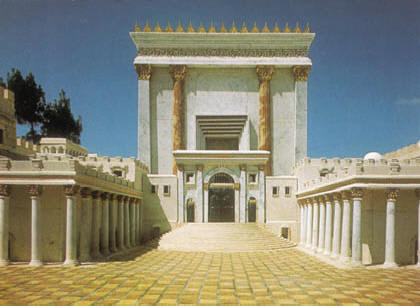The Purim miracle was a “milestone moment” in Jewish History as a nation, faced with almost certain annihilation, was rescued by Divine intervention. Unlike the Exodus from Egypt, the Purim experience unfolded without overt Divine involvement. It reminded us that G-d always manages history – sometimes in a manifest fashion while other times ‘behind the scenes.’
However, one cannot fully appreciate the impact of Purim without casting these events within a broader historical framework. According to the traditional timeline, Purim occurred around seventy years after the first phase of Jewish exile. This first stage, known as the exile of King Yechanaya, preceded the actual destruction of the Mikdash by approximately eighteen years. Purim occurs around seventy years after the first wave of exile in the shadow of the catastrophic destruction of the First Temple.
Everyone reading this article was born into a world without a Mikdash and without full Jewish sovereignty. By contrast, the generations who lived in that world of miracles, prophecy and supernaturalism, were traumatized by the destruction of the Temple. According to Chazal the one-hundred-and-eighty-day party in Shushan was pivoted upon drinking from the holy keilim or jugs of the Mikdash. One can only imagine the sting for those who still remembered the Mikdash ceremonies with those same vessels. Perhaps this is why Chazal were so critical of those who participated in this wanton party; regardless of the kashrus level, a Jew has no place at a party which contaminates these holy Mikdash remnants. Purim unfolds at a dark and despairing period of Jewish history.
The depressed plight of the Jews was also noticed by Haman-a wise man who had risen to become the king’s trusted adviser. How did he commit such a gargantuan mistake in plotting against the Jews? So many before him, from Paro to Nevuchadnezer, had tried and failed to defeat the people of G-d. How did this student of history commit such a foolish mistake?
Haman read the tea leaves: The Jews had indeed been chosen as G-d’s children but were discarded because of their continuous infidelity. The period of the First Temple was marred by years of shameful paganism and brutal murder. The Jews were no longer G-d’s children and they were now ripe for the picking. In many respects Haman was the first “Christian.” Obviously he wasn’t a religious Christian but he was the first to lodge the claim which Christianity would ultimately institutionalize and perpetuate- that G-d had discarded his rebellious former children while choosing another people.
In fact, Haman’s historical gamble is latent in the conspiratorial plan he delivers to Achashverosh. He refers to the Jewish people as a nation that is “mefuzar u’meforad bein ha’amim” dispersed randomly amongst the general population. This contemptuous phrase showcases not merely their geographical scattering, but also Haman’s opinion that they had been demoted to a “regular” nation status-diffused among the nations of the world. No longer possessing the unique status as G-d’s children, they could now be vanquished. The thousand-year period of prophecy and revelation had now ground to a halt and history was ready to “move on” from the Jews. Witnessing his lottery select the month of Adar for his genocide, only reaffirmed Haman’s convictions. The great era of Jewish selection began in Nissan but it was now slowly expiring, coughing its last breaths at the conclusion of the calendar year in Adar.
The dramatic Purim turnaround revitalized the fallen Jewish spirit. It reminded the world-but more importantly the Jewish nation-that the original selection of the Jews was immutable. Despite our disloyalty and religious lethargy, we remained “chosen” and were still protected, even in the fields of our enemies. Purim possesses a tone of Sinai because it reaffirmed the pact of Sinai formed centuries earlier. The Jews are, and will always be, G-d’s people, chosen to represent Him in this world.
What occurred close to 2,500 years ago recurred seventy years ago. The historical rupture of the Holocaust dealt a potentially devastating blow to Jewish identity. How could our Father and Protector allow the systematic elimination of six-million Jews? Weren’t we promised safeguarding and Divine protection? Of course, many Jews emerged from this nightmare with their faith intact but much of our nation faced a haunting question-were we still chosen? Just as He did then, G-d reminded us that we were still his chosen people. He collected us from across the globe and returned us to our homeland. This miracle reminded us that we still possesses our special status. It rejuvenated Jewish identity and pride across the globe. The phenomenal growth over the past seventy years in Jewish culture, community building, economic influence, political activism and, of course, in Torah study would have been seriously hampered without the restored confidence which the renewed state of Israel provided.
Beyond national rejuvenation, there was a second historical function to the Purim miracle. Purim unfolds as the Jews had already returned to Jerusalem and had launched the construction of the second Mikdash. However, the project was stalled in the face of stiff and hostile opposition from locals in Israel opposed to Jewish expansionism. According to the Sefat Emmet, the Purim miracle was a pre-redemptive event to provide “thrust” for the ultimate redemption. Without the national energy provided by the Purim miracle the final return to Israel and construction of the second Mikdash would have been significantly delayed. Purim provided historical thrust for the final stages of Jewish redemption. Will the founding of the State of Israel function in our era in the same manner? Obviously, we aren’t “fully” redeemed as we still lack so much in our beloved State. Will 1948 be recorded in history as the modern-day Purim? Will this serve as the pre-redemptive event which provides the thrust to achieve ultimate redemption?
We certainly hope so and pray for this to be so. Purim samei’ach!
The words of this author reflect his/her own opinions and do not necessarily represent the official position of the Orthodox Union.
